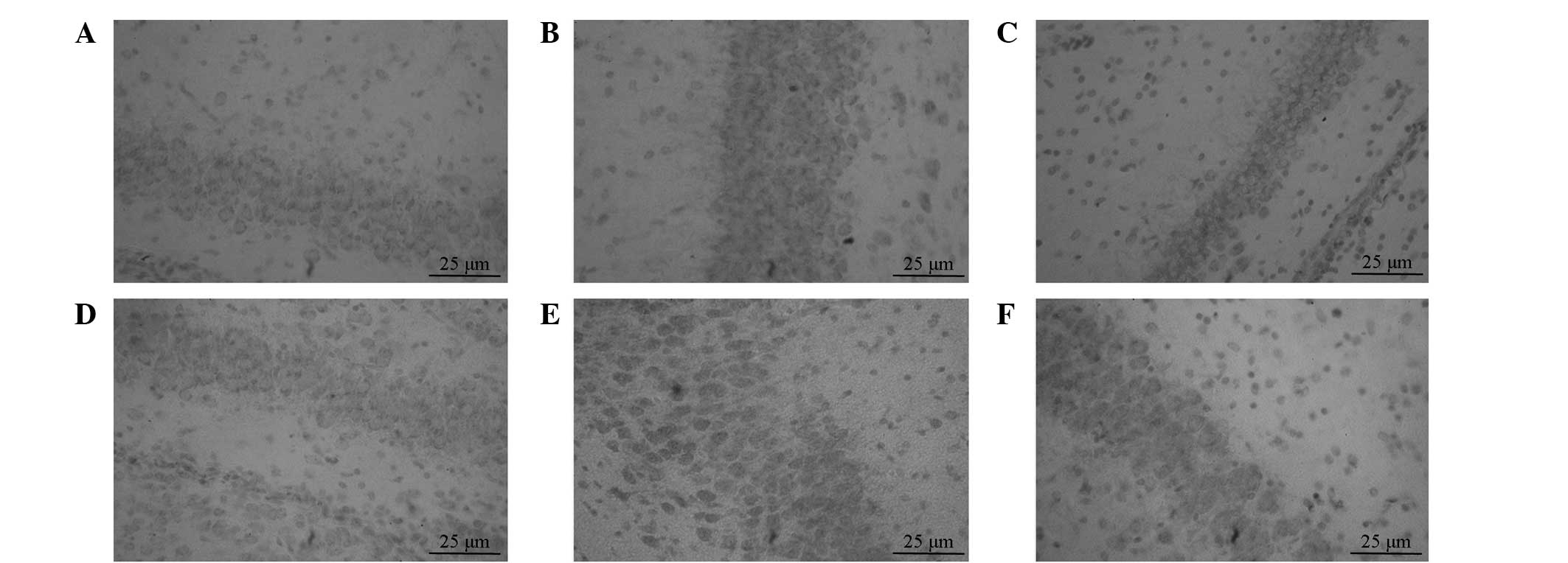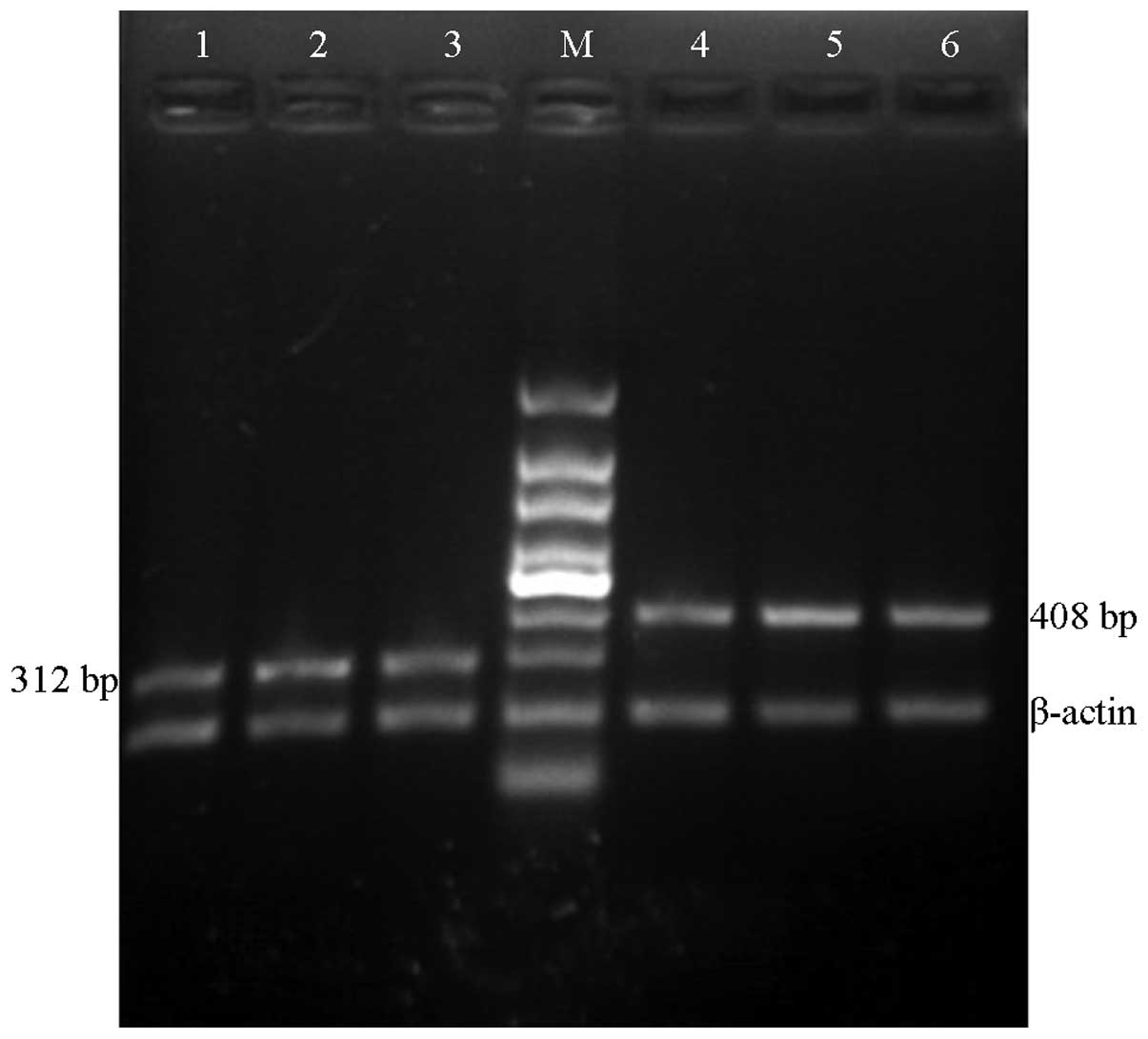|
1
|
Doi K, Sameshima H, Kodama Y, Furukawa S,
Kaneko M and Ikenoue T; Miyazaki Perinatal Data Groups. Perinatal
death and neurological damage as a sequential chain of poor
outcome. J Matern Fetal Neonatal Med. 25:706–709. 2012. View Article : Google Scholar : PubMed/NCBI
|
|
2
|
Northington FJ, Chavez Valdez R and Martin
LJ: Neuronal cell death in neonatal hypoxia-ischemia. Ann Neurol.
69:743–758. 2011. View Article : Google Scholar : PubMed/NCBI
|
|
3
|
Vannucci SJ and Hagberg H:
Hypoxia-ischemia in the immature brain. J Exp Biol. 207:3149–3154.
2004. View Article : Google Scholar : PubMed/NCBI
|
|
4
|
Sasaoka N, Kawaguchi M, Kawaraguchi Y, et
al: Isoflurane exerts a short-term but not a long-term
preconditioning effect in neonatal rats exposed to a
hypoxic-ischaemic neuronal injury. Acta Anaesthesiol Scand.
53:46–54. 2009. View Article : Google Scholar : PubMed/NCBI
|
|
5
|
Boggio PS, Coutinho de Macedo E,
Pascual-Leone A, Tormos Muñoz JM, Schwartzman JS and Fregni F:
Neuromodulation in hypoxic-ischemic injury. Brain Stimul.
2:179–181. 2009. View Article : Google Scholar : PubMed/NCBI
|
|
6
|
Zhao P and Zuo Z: Isoflurane
preconditioning induces neuroprotection that is inducible nitric
oxide synthase-dependent in neonatal rats. Anesthesiology.
101:695–703. 2004. View Article : Google Scholar : PubMed/NCBI
|
|
7
|
Liu F and McCullough LD: Inflammatory
responses in hypoxic ischemic encephalopathy. Acta Pharmacol Sin.
34:1121–1130. 2013. View Article : Google Scholar : PubMed/NCBI
|
|
8
|
Kasdorf E and Perlman JM: Hyperthermia,
inflammation, and perinatal brain injury. Pediatr Neurol. 49:8–14.
2013. View Article : Google Scholar : PubMed/NCBI
|
|
9
|
Bonestroo HJ, Nijboer CH, van Velthoven
CT, Kavelaars A, Hack CE, van Bel F and Heijnen CJ: Cerebral and
hepatic inflammatory response after neonatal hypoxia-ischemia in
newborn rats. Dev Neurosci. 35:197–211. 2013. View Article : Google Scholar : PubMed/NCBI
|
|
10
|
Walberer M, Rueger MA, Simard ML, Emig B,
Jander S, Fink GR and Schroeter M: Dynamics of neuroinflammation in
the macrosphere model of arterio-arterial embolic focal ischemia:
an approximation to human stroke patterns. Exp Transl Stroke Med.
2:222010. View Article : Google Scholar : PubMed/NCBI
|
|
11
|
Baker SJ and Reddy EP: Modulation of life
and death by the TNF receptor superfamily. Oncogene. 17:3261–3270.
1998. View Article : Google Scholar : PubMed/NCBI
|
|
12
|
Chung HS, Kim SN, Jeong JH and Bae H: A
novel synthetic compound
4-acetyl-3-methyl-6-(2-bromophenyl)pyrano[3,4-c]pyran-1,8-dione
inhibits the production of nitric oxide and proinflammatory
cytokines via the NF-κB pathway in lipopolysaccharide-activated
microglia cells. Neurochem Res. 38:807–814. 2013.PubMed/NCBI
|
|
13
|
Nijboer CH, Heijnen CJ, Groenendaal F, May
MJ, van Bel F and Kavelaars A: A dual role of the NF-kappa B
pathway in neonatal hypoxic-ischemic brain damage. Stroke.
39:2578–2586. 2008. View Article : Google Scholar : PubMed/NCBI
|
|
14
|
Su JR, Zhao ZC, Chen WL and Wang X: The
effect of activated nuclear factor-kappaB in pathogenesis of acute
pancreatitis. Zhonghua Yi Xue Za Zhi. 83:1497–1500. 2003.(In
Chinese).
|
|
15
|
Gesslein B, Håkansson G, Gustafsson L,
Ekström P and Malmsjö M: Tumor necrosis factor and its receptors in
the neuroretina and retinal vasculature after ischemia-reperfusion
injury in the pig retina. Mol Vis. 16:2317–2327. 2010.PubMed/NCBI
|
|
16
|
Pettus EH, Wright DW, Stein DG and Hoffman
SW: Progesterone treatment inhibits the inflammatory agents that
accompany traumatic brain injury. Brain Res. 1049:112–119. 2005.
View Article : Google Scholar : PubMed/NCBI
|
|
17
|
Singh M and Su C: Progesterone-induced
neuroprotection: factors that may predict therapeutic efficacy.
Brain Res. 1514:98–106. 2013. View Article : Google Scholar : PubMed/NCBI
|
|
18
|
Baudry M, Bi X and Aguirre C:
Progesterone-estrogen interactions in synaptic plasticity and
neuroprotection. Neuroscience. 239:280–294. 2013. View Article : Google Scholar : PubMed/NCBI
|
|
19
|
Li DL, Zhao HG, Wang DX and Ding YF:
Effect of progesterone on cerebral cortex edema in rats exposed to
focal ischemia/reperfusion. Zhongguo Ying Yong Sheng Li Xue Za Zhi.
17:327–329. 2001.(In Chinese).
|
|
20
|
Li DL and Han H: Effect of progesterone on
the expression of GLUT in the brain following hypoxic-ischemia in
newborn rats. Zhongguo Ying Yong Sheng Li Xue Za Zhi. 24:353–355.
2008.(In Chinese).
|
|
21
|
Wang X, Zhang J, Yang Y, Dong W, Wang F,
Wang L and Li X: Progesterone attenuates cerebral edema in neonatal
rats with hypoxic-ischemic brain damage by inhibiting the
expression of matrix metalloproteinase-9 and aquaporin-4. Exp Ther
Med. 6:263–267. 2013.PubMed/NCBI
|
|
22
|
Rice JE 3rd, Vannucci RC and Brierley JB:
The influence of immaturity on hypoxic-ischemic brain damage in the
rat. Ann Neurol. 9:131–141. 1981. View Article : Google Scholar : PubMed/NCBI
|
|
23
|
Taniguchi H and Andreasson K: The
hypoxic-ischemic encephalopathy model of perinatal ischemia. J Vis
Exp. 19:9552008.
|
|
24
|
Chen G, Shi J, Ding Y, Yin H and Hang C:
Progesterone prevents traumatic brain injury-induced intestinal
nuclear factor kappa B activation and proinflammatory cytokines
expression in male rats. Mediators Inflamm. 2007:934312007.
View Article : Google Scholar
|
|
25
|
Sarkaki AR, Khaksari Haddad M, Soltani Z,
Shahrokhi N and Mahmoodi M: Time- and dose-dependent
neuroprotective effects of sex steroid hormones on inflammatory
cytokines after a traumatic brain injury. J Neurotrauma. 30:47–54.
2013. View Article : Google Scholar : PubMed/NCBI
|
|
26
|
Aggarwal R, Medhi B, Pathak A, Dhawan V
and Chakrabarti A: Neuroprotective effect of progesterone on acute
phase changes induced by partial global cerebral ischaemia in mice.
J Pharm Pharmacol. 60:731–737. 2008. View Article : Google Scholar : PubMed/NCBI
|
|
27
|
Tsuji M, Taguchi A, Ohshima M, Kasahara Y
and Ikeda T: Progesterone and allopregnanolone exacerbate
hypoxic-ischemic brain injury in immature rats. Exp Neurol.
233:214–220. 2012. View Article : Google Scholar : PubMed/NCBI
|
|
28
|
Gustavsson M, Wilson MA, Mallard C,
Rousset C, Johnston MV and Hagberg H: Global gene expression in the
developing rat brain after hypoxic preconditioning: involvement of
apoptotic mechanisms? Pediatr Res. 61:444–450. 2007. View Article : Google Scholar : PubMed/NCBI
|
|
29
|
Rouse DJ, Hirtz DG, Thom E, et al; Eunice
Kennedy Shriver NICHD Maternal-Fetal Medicine Units Network. A
randomized, controlled trial of magnesium sulfate for the
prevention of cerebral palsy. N Engl J Med. 359:895–905. 2008.
View Article : Google Scholar : PubMed/NCBI
|
|
30
|
O’Connor JJ: Targeting tumour necrosis
factor-α in hypoxia and synaptic signalling. Ir J Med Sci.
182:157–162. 2013.
|
|
31
|
Barone FC, Arvin B, White RF, et al: Tumor
necrosis factor-alpha. A mediator of focal ischemic brain injury.
Stroke. 28:1233–1244. 1997. View Article : Google Scholar : PubMed/NCBI
|
|
32
|
Guo M, Lin V, Davis W, et al: Preischemic
induction of TNF-alpha by physical exercise reduces blood-brain
barrier dysfunction in stroke. J Cereb Blood Flow Metab.
28:1422–1430. 2008. View Article : Google Scholar : PubMed/NCBI
|
|
33
|
Sen R and Baltimore D: Inducibility of
kappa immunoglobulin enhancer-binding protein NF-kappaB by
posttranslational mechanism. Cell. 47:921–928. 1986. View Article : Google Scholar : PubMed/NCBI
|
|
34
|
Kaufmann JA, Bickford PC and Taglialatela
G: Free radical-dependent changes in constitutive Nuclear factor
kappa B in the aged hippocampus. Neuroreport. 13:1917–1920. 2002.
View Article : Google Scholar : PubMed/NCBI
|
|
35
|
Lee HJ, Oh TH, Yoon WJ, et al: Eutigoside
C inhibits the production of inflammatory mediators (NO, PGE(2),
IL-6) by down-regulating NF-kappaB and MAP kinase activity in
LPS-stimulated RAW 264.7 cells. J Pharm Pharmacol. 60:917–924.
2008. View Article : Google Scholar : PubMed/NCBI
|
|
36
|
Brown KD, Claudio E and Siebenlist U: The
roles of the classical and alternative nuclear factor-kappaB
pathways: potential implications for autoimmunity and rheumatoid
arthritis. Arthritis Res Ther. 10:2122008. View Article : Google Scholar : PubMed/NCBI
|
|
37
|
Hayden MS and Ghosh S: Shared principles
in NF-kappaB signaling. Cell. 132:344–362. 2008. View Article : Google Scholar : PubMed/NCBI
|
|
38
|
Wang X, Zhang J, Si D, et al: Progesterone
inhibits the expression of cycloxygenase-2 and interleukin-1β in
neonatal rats with hypoxic ischemic brain damage. Int J Neurosci.
124:42–48. 2014.PubMed/NCBI
|

















